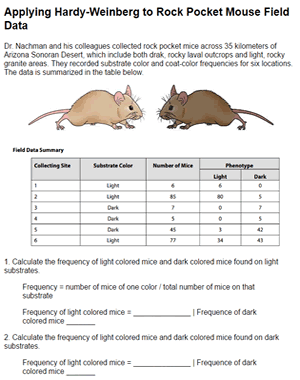
In this activity, students use real world data on the color distribution of rock pocket mice. Students quantify changes in mouse coloration depending on where the mice live.
Students may have completed a basic version of the rock pocket mouse activity as freshman. As students progress in biology, they learn that evolution and natural selection can be quantified mathematically. Hardy Weinberg equilibrium is a principle stating that the genetic variation in a population will remain constant in the absence of disturbing factors.
In this case, the “disturbing factor” is the presence of predators which hunt by sight. Dark mice have an advantage on dark rocky substrates. The allele frequency of the dark color will increase in those areas. Contrarily, frequency of light colored mice increases in areas with sandy substrates.
Students use data from mouse populations to apply the Hardy Weinberg equation. In the worksheet, the steps are very clear, suitable for beginners to HW Equilibrium. I usually model the steps with them if this is their first lesson on allele frequencies.
Students can also practice using the HW equation with this problem set.
Students can also practice population genetics with the Fishbowl Virtual Simulation.
Evolution Resources at HHMI BioInteractive
This activity can be included in a longer study on rock pocket mice that can be accessed at BioInteractive. HHMI has many amazing resources on evolution, for all age groups. Another great model organism for studying evolution is the stickleback fish.
Grade Level: 10-12 | Time Required: 20 minutes
NGSS: HS-LS4-5 Evaluate the evidence supporting claims that changes in environmental conditions may result in: (1) increases in the number of individuals of some species, (2) the emergence of new species over time, and (3) the extinction of other species.

